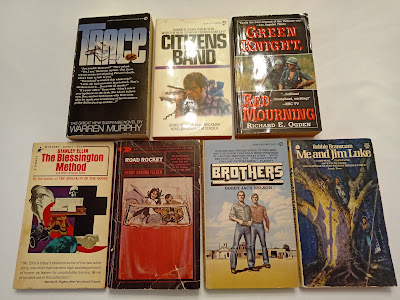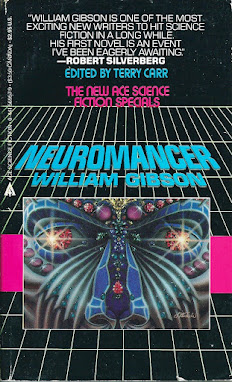Book Review: 'The City: 2000 A.D.'
edited by Ralph Clem, Martin Harry Greenberg, and Joseph Olander
3 / 5 Stars
'The City: 2000 A.D. Urban Life Through Science Fiction' (304 pp.) was published by Fawcett Crest in July, 1976. The cover art is attributed to Larry Kresek.
This was the first of two sci-fi anthologies co-edited by Ralph Clem and the indefatigable Martin Greenberg, the other being 'No Room for Man' (1979). These anthologies, as well as others published by Olander and Greenberg in the 1970s, were of educative intent, designed to be textbooks for high school and college courses.
As such, the Clem / Olander / Greenberg productions were among the more accessible sci-fi anthologies of the New Wave era, as they necessarily relied upon short fiction that was devoid of the unconventional, avant-garde mannerisms that marked much of the New Wave's output of that era.
'The City' contains stories first published during the interval from 1911 to 1975. Some of the stories previously appeared in Roger Elwood's 'Future City' anthology from 1973. And some of the entries here in 'The City: 2000 A.D.' are present in 'No Room for Man'.
Each of the entries in 'The City: 2000 A.D.' has an introduction from the editors; these introductions are pedantic, admonitory, and tinged with a progressive, liberal political ideology. It's clear that the editors view the city as a malevolent construct, and the selections in this anthology are designed to reflect this view.
My capsule summaries of the contents:
New York A.D. 2660 (1911), Hugo Gernsback: an excerpt from Gernsback's novel. It's mainly of interest as one of sci-fi's first treatments of the modern city as a technological wonderland, the apogee of American resourcefulness.
Jesting Pilot (1947), by Henry Kuttner: the Future City is bounded by an impenetrable wall; a malcontent persists in wondering about what lies outside the wall. I've never been much of a fan of Henry Kuttner, and this story, with its stilted prose and inane plotting, reminds me why. It's the worst entrant in the anthology.
Chicago (1973) • short story by Thomas F. Monteleone: the future metropolis is completely automated; a robot questions why.
Street of Dreams, Feet of Clay (1967), by Robert Sheckley: fed up with the rat race of life in an overcrowded, polluted New York City, Edward Carmody decides to visit the 'smart city' of Bellwether, New Jersey. An underwhelming social satire from Sheckley.
The Vanishing American (1955), by Charles Beaumont: the impersonalized nature of life in the Future City drives Mr. Michell into a profound state of alienation.
Billennium (1961), by J. G. Ballard: despite the passage of the decades, this tale of the street-level reality of overpopulation remains one of the most powerful treatments of the topic.
Total Environment (1968), by Brian W. Aldiss: 500 young Indian couples are sequestered in an arcology and left to their own devices; it is an experiment designed to see how humans cope with severe overcrowding. Aldiss clearly intended this story to explore the implications of the iconic 'behavioral sink' rodent experiments conducted in the late 1960s at NIH by zoologist John B. Calhoun. In this regard, 'Total Environment' is an exemplar of the sci-fi of the Population Bomb era, and one of Aldiss's better novelettes.
Black Is Beautiful (1970), by Robert Silverberg: this story first appeared in Harry Harrison's 1970 anthology 'The Year 2000'. In Silverberg's story, White Flight has led to Manhattan being covered with a transparent dome, and black people constituting the overwhelming majority of the population. A youngblood named James Shabazz is out to make sure Whitey understands his place in the new social order, you dig, baby ? A cool tale from Silverberg.
In Dark Places (1973), by Joe L. Hensley: gritty, grim tale of racial warfare in a decrepit near-future cityscape. Its offbeat, proto-Cyberpunk sensibility makes it another of the standout stories in the anthology.
East Wind, West Wind (1972), by Frank M. Robinson: in a devastatingly polluted Future City, the protagonist investigates a report of someone operating banned machinery: a gasoline-driven car. An effective Eco-Catastrophe tale from the genre's heyday in the early 70s.
Disposal (1970), by Ron Goulart: when Lon's futuristic garbage disposal breaks, it means disaster for the entire family.
The Undercity (1973), by Dean R. Koontz: in the Future City, liberal reformers have made permissible offenses that, in the past, were felonies. But that doesn't stop enterprising criminals from making a living from breaking the law, often in ingenious ways.
Gas Mask (1964), by James D. Houston: brilliant little tale about the Traffic Jam from Hell.
Traffic Problem (1970), by William Earls: dark satire of a future New York city where traffic is so bad the World Trade Center is encircled by highways, and Central Park has been converted to a parking lot.
Gantlet (1972), by Richard E. Peck: this story first appeared in 'Orbit 10' (1972) and it's among the few stories in that series, that I read back in the early 70s, that I found engaging enough to stay with me over the ensuing decades.
'Gantlet' is about a commute out of the Future City and into the suburbs. A commute that involves a passenger train with metal shields fitted over the windows, and machine guns and lasers mounted on the engine car. Needless to say, the train will be going through some very tough neighborhoods en route to its destination.........! There is a proto-cyberpunk atmosphere to this story.
City's End (1973), by Mack Reynolds: New York City circa 2000 AD is a depopulated wasteland, a refuge to outcasts and criminals. Teenager Bobby tries to survive, aided by his .22 rifle. The opening segments of this story have an impactful, dystopian quality, but, as the story progresses, Reynolds inevitably introduces discourses on political theory; these drain momentum from the narrative.
The Slime Dwellers (1975), by Scott Edelstein: to reduce urban blight, a space-age suburb is constructed in 'Basin City'. But.........what if no one wants to buy a house in Basin City ?!
A Happy Day in 2381 (1970), by Robert Silverberg: in the Future City, Earth's population of 75 billion live in arcologies three kilometers high. Mattern, an inhabitant of one such arcology, hosts a visitor whose remarks leave Mattern wondering about the wisdom of Unchecked Fecundity. Silverberg later would bundle this story into his 1971 fixup The World Inside.
The verdict ? There are enough good stories to give 'The City: 2000 A.D.' a solid 3-Star review. This is an anthology that displays sci-fi's 1970s pessimism to good effect, particularly the entries by Aldiss, Silverberg, Hensley, Houston, Earls, and Peck. If you like stories that fall into the same bin with pop culture classics like The Omega Man, Soylent Green, and Escape from New York, then this is worth picking up.
















































































